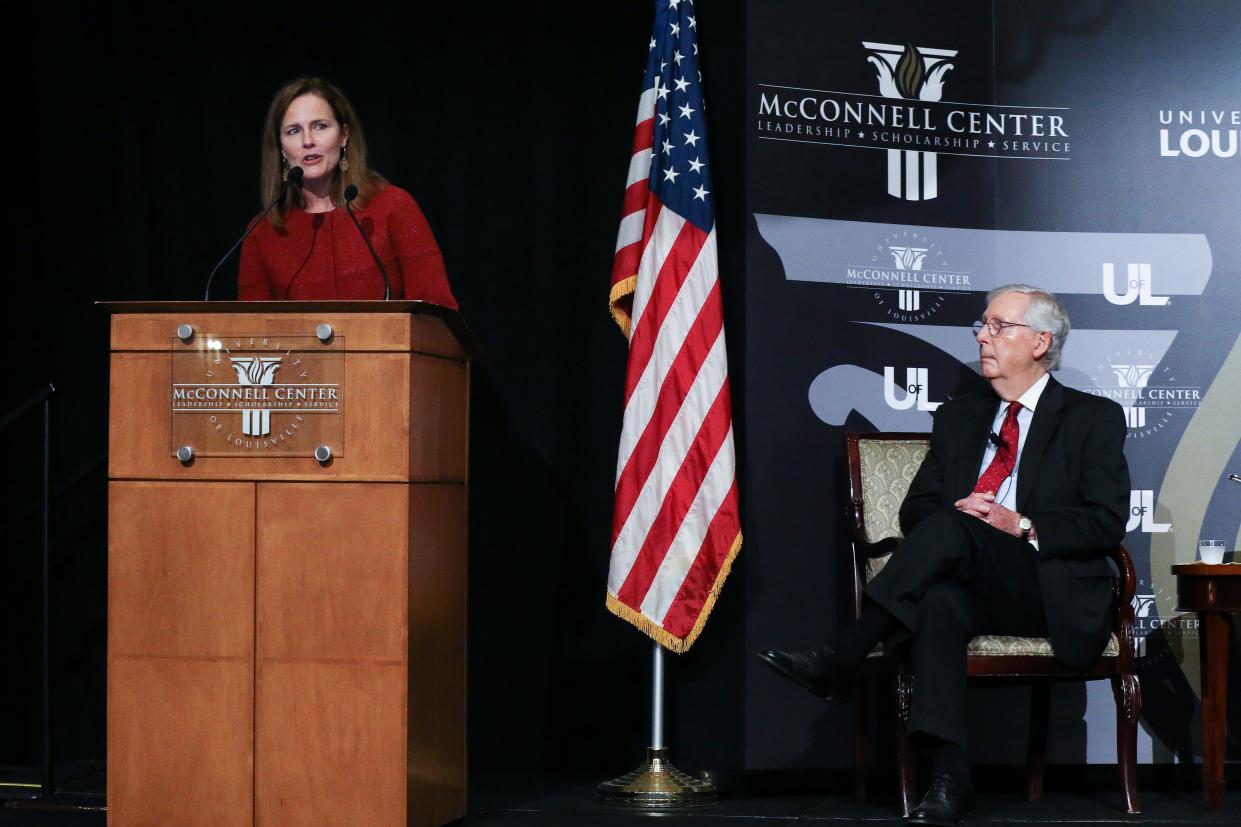Supreme Court justices using 'shadow docket' in a partisan way

- Oops!Something went wrong.Please try again later.
- Oops!Something went wrong.Please try again later.
Is the U.S. Supreme Court comprised of “a bunch of partisan hacks”?
Justice Amy Coney Barrett disputed the idea at an event for a center founded by Senate Minority Leader Mitch McConnell. For an answer to this question, let’s review Justice Barrett’s statements during her nomination hearing and, more recently, and the Supreme Court’s use of the shadow docket.
At her nomination hearing, Barrett demonstrated a predilection for ruling in a partisan manner when she answered Sen. Kamala Harris’ question about whether she believed climate change is happening, stating that Harris was trying to “elicit an opinion from me on a very contentious matter of public debate and I will not do that. I will not express a view on a matter of public policy especially one that is politically controversial because that’s inconsistent with judicial rule.
Climate change is a fact and it’s also a fact that it’s being driven to a large extent by the burning of fossil fuels. Inability to acknowledge indisputable facts leaves Barrett with no option other than to render opinions informed by her partisan viewpoint.
Recently, Barrett expounded upon her “bunch of partisan hacks” comment, insisting that judges are not deciding cases to impose a political result. She urged Americans to “read the opinion” and determine whether it “reads like something purely results driven and designed to impose the policy preferences of the (Supreme Court) majority.”
Two days later she joined the majority (in a 5-4 decision — Chief Justice John Roberts and associate justices Sonia Sotomayor, Elena Kagan and Stephen Breyer dissenting) in issuing yet another shadow docket decision (a decision rendered without a hearing or argument and often, including here, without an opinion). The decision revived a Trump-era Clean Water Act rule restricting the ability of states and tribes to block pipelines or other projects that frequently damage the environment.
This is only the most recent in a string of Supreme Court shadow docket decisions, including:
• Another 5-4 decision, which overruled two judicious and exhaustively supported lower court opinions and reinstated a congressional district map in Alabama that specifically diluted Black votes (the majority provided no opinion or explanation — Justice Brett Kavanaugh, joined by Justice Samuel Alito, issued a concurring opinion, contending five months was too close to voting day to establish new districts).
• A 6-3 decision allowing Texas’ unconstitutional (under existing U.S. Supreme Court law) abortion ban to remain in effect.
• Seven shadow docket decisions, many rendered with little or no explanation, which overturned lower court rulings and cleared the way for the first federal executions in 17 years (one of the defendants had obtained a stay by an en banc decision — a decision in which all the judges participate — of the D.C. Circuit which ordered a briefing schedule that would have taken the litigation past the Biden inauguration).
• A 6-3 decision enjoining California from enforcing a COVID restriction prohibiting large indoor gatherings, including in a church (thereby elevating the opinion of the court’s majority over the recommendations of public health experts).
Barrett’s and the Supreme Court majorities’ widespread use of the shadow docket to overrule lower court decisions, often while offering no or only the briefest of explanations, proves the fallacy of her claim that Supreme Court decisions are not “results driven and designed to impose the policy preferences of the majority.”
In many cases you can't "read the opinion" because there is no opinion to read. Thus, the Supreme Court's extensive use of the shadow docket fails Barrett's own test. It’s no wonder the Supreme Court is increasingly seen to be comprised of “a bunch of partisan hacks."
Terence Kann is a Gainesville attorney.
Join the conversation
Send a letter to the editor (up to 200 words) to letters@gainesville.com. Letters must include the writer's full name and city of residence. Additional guidelines for submitting letters and longer guest columns can be found at bit.ly/sunopinionguidelines.
Journalism matters. Your support matters.
Get a digital subscription to the Gainesville Sun. Includes must-see content on Gainesville.com and Gatorsports.com, breaking news and updates on all your devices, and access to the eEdition. Visit www.gainesville.com/subscribenow to sign up.
This article originally appeared on The Gainesville Sun: Terence Kann: Supreme Court using 'shadow docket' in partisan way

